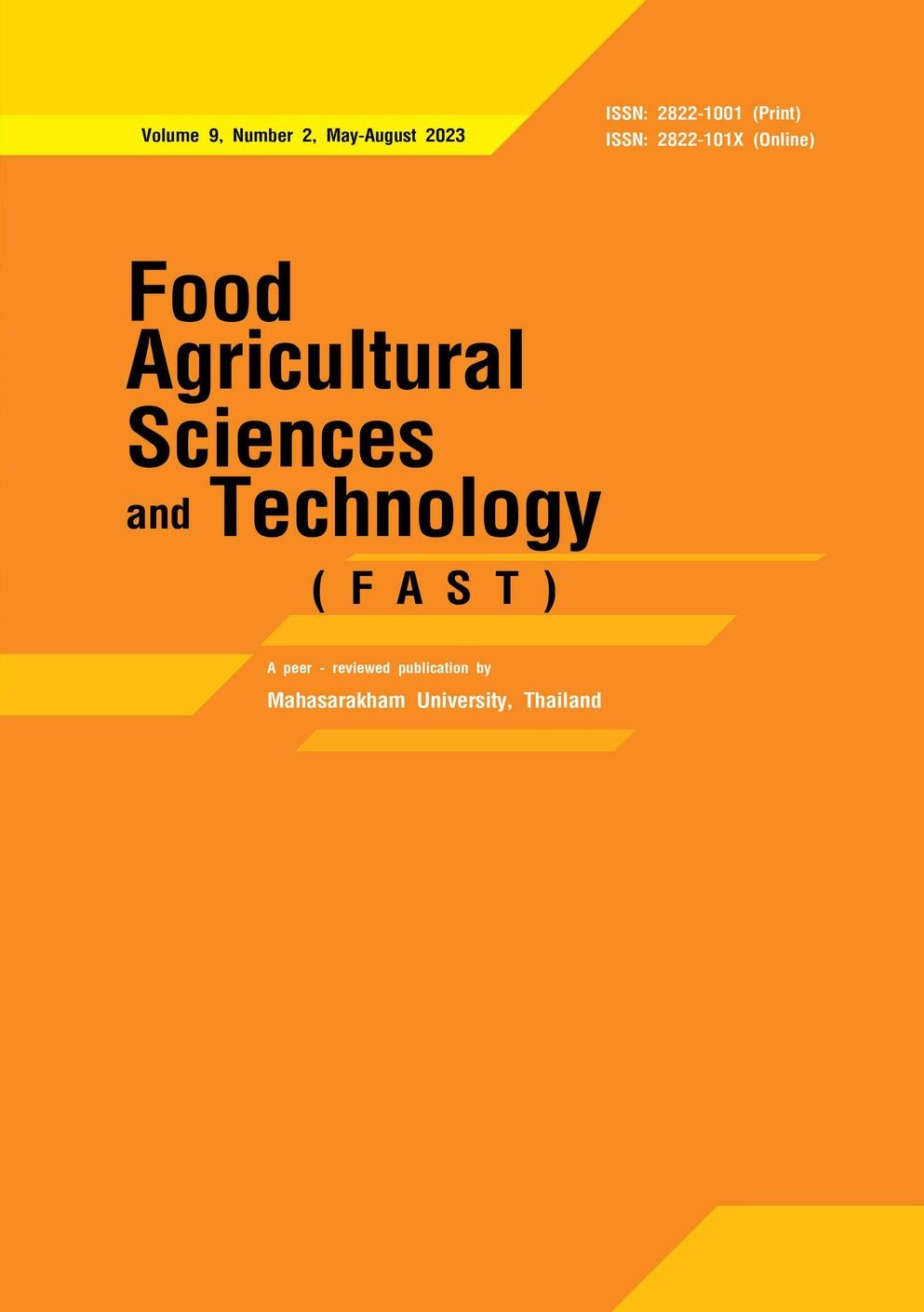Synthesis and characterization of carboxymethyl cellulose from pineapple core
Keywords:
Carboxymethyl cellulose, cellulose, degree of substitution, pineapple core, purityAbstract
Abstract - Pineapple core is one of waste left over after pineapple processing. It could be increased value by maximally utilizing certain composition. Cellulose, an abundant compound in pineapple core, could be extracted and purified by removing lignin and hemicellulose. Moreover, it could be converted into carboxymethyl cellulose (CMC) for wide application. The objective of this research was to synthesize the CMC extracted from pineapple core (P-CMC). This process provided P-CMC with the purity of 95.86% at the processing yield about 89.78%. The degree of substitution was 0.83, which is commercially acceptable. Fourier transform infrared spectroscopy revealed the chemical structure of the synthesized P-CMC. Observation of the peak the IR spectra, at a wave number of 1588 cm-1, exhibited the presence of a carboxyl group (COO-) in the P-CMC. This suggested the similarity carboxymethyl substitution comparable to that of commercial CMC. The P-CMC, expressed high potential for commercial production.
Keywords: Carboxymethyl cellulose, cellulose, degree of substitution, pineapple core, purity
References
A/S Niro Atomizer. (1978). Determination of wettability. http://www.niro.com ASTM, (2016). Standard test methods for sodium carboxymethylcellulose, ASTM D1439-03.
ASTM International. Biswal, D. R., & Sing, R. P. (2004). Characterization of carboxymethyl cellulose and polyacrylamide graft copolymer. Carbohydrate Polymers, 57, 379-387. https://doi.org/10.1016 /j.carbpol.2004.04.020
Bono, J. E., Purvanova, R. K., Towler, A. J., & Peterson, D. B. (2009). A survey of executive coaching practices. Personnel Psychology, 62(2), 361-404. https://doi.org/10.1111/ j.1744-6570.2009.01142.x
Borsa, J., & Racz, I. (1995). Carboxymethylcellulose of fibrous character-a survey. Cellulose Chemistry and Technology, 29, 657-663.
Devani, G., Tapia-Blcido, D. R., Anon, M. C., Sobral, P. J. A., Mauri, A. N., & Menegalli, F. C. (2009). Effect of drying conditions on some physical properties of soy protein films. Journal of Food Engineering, 90, 341-349.https://doi.org/10.1016/ j.jfoodeng.2008.07.001
Hemung, B., Sompholkrang, M., Wongchai, A., Chanshotikul, N., & Ueasin, N. (2022). A study of the potential of by-products from pineapple processing in Thailand: Review article. International Journal of Health Sciences, 6(4), 12605- 12615. https://doi.org/10.53730/ ijhs.v6nS4.12131
Kanokpanont, S., Inthaphunt, S., & Bunsiri, A. (2017). Synthesis of Carboxymethyl Cellulose from Young Coconut Husk. Songklanakarin Journal of Plant Science, 4(4), 60-65. https:// doi.org/10.1063/5.0100387
Krisdayanti, G., Ayn, T. W., & Gita, R. N. (2017). Synthesis and characterization of sodium. carboxymethylcellulose from pod husk of Cacao (Theobroma cacao L.). Advances in Food Science and Technology, 5(9), 001-006.
Meenakshi, P., Noorjahan, S. E., Rajini, R., Venkatesvalu, U., Rose, C., & Sastry, T. P. (2002). Mechanical and microstructure study on the modification of cellulose acetate (CA) film by blending with polystyren (PS). Bulletin of Materials Science, 25(1), 2529.
Pescok, R. L., Shields, L. D., Caims T., & McWilliam, I. G. (1976). Modern methods of chemical analysis. NY Wiley. Pormsila, W., Kongsantear, D., & Prasongsuk, P. (2019). Production and Characterization of Carboxymethyl Cellulose from Orange Rind. RMUTP Research Journal, 13(1). https:// doi.org/10.14456/jrmutp.2019.11
Prakongpan, T., Nittihamyong, A., & Luangpituksa, P. (2002). Extraction and application of dietary fiber and cellulose from pineapple cores. Journal of Food Science, 67(4), 1308-1313. https://doi.org/10.1111 /J.1365-2621.2002.TB10279.X
Pushpamalar, V., Langford, S. J., Ahmad, M., & Lim, Y. Y. (2006). Optimization of reaction conditions for preparing carboxymethylcellulose from sago waste. Carbohydrate Polymers, 64, 312-318. https://doi. org/10.1016j.carbpol.2005.12.003
Rasid, N. S. A. B., Zainol, M. M., & Amin, N. A. S. (2021). Synthesis and Characterization of Carboxymethyl Cellulose Derived from Empty Fruit Bunch. Sains Malaysiana, 50(9), 2523-2535. https://doi. org/10.17576/ jsm-2021-5009-03
Rachtanapun, P. (2009). Blended films of carboxymethyl cellulose from papaya peel and corn starch. Kasetsart Journal - Natural Science, 43, 259-266.
Rachtanapun, P., Luangkamin, S., Tanprasert, K., & Suriyatem, R. (2012). Carboxymethyl cellulose film from durian rind. LWT-Food Science and Technology, 48(1), 52-58.
Saengchu, N., Puttnual, C., Pongsakchat, V., Limroongreungrat, K., & Sangnark, A. (2008). Optimum method and conditions of carboxymethyl cellulose production from rice straw. KMUTT Research and Development Journal, 31(4), 797-809.
Saengchu, N., Puttnual, C., Pongsakchat, V., Limroongreungrat, K., & Sangnark, A. (2007). Optimum method and conditions of carboxymethyl cellulose production from rice straw. KMUTT Research and Development, 31(4), 797-809.
Srithiang, K., Prachakiew, S., & Boonchauy, S. (2019). Development products of biomass briquettes production from pineapple peel. Journal of Innovative Technology Research, 3(1), 101-110.
Thomas, G. M., Paquita, E. M., & Thomas, J. P. (2002). Cellulose ethers. Encyclopedia of polymer science and technology. Wiley.
Viera, R. G. P., Filho, G. R., Assuncao, R. M. N., Meireles, C. S., Vieira, J. G., & Oliveira, G. S. (2007). Synthesis and characterization of methylcellulose from sugar cane bagasse Cellulose. Carbohydrate Polymers, 67, 182-189.https://doi. org/10.1016/j.carbpol.2006.05.007
Downloads
Published
How to Cite
Issue
Section
License
Copyright (c) 2023 Food Agricultural Sciences and Technology (FAST)

This work is licensed under a Creative Commons Attribution-NoDerivatives 4.0 International License.







